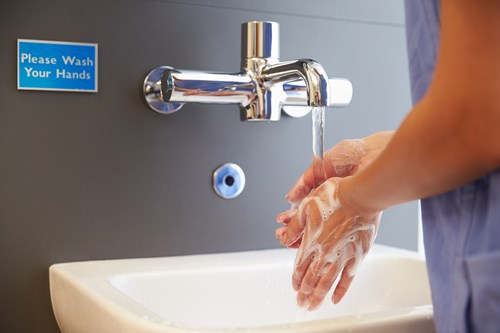
It is no surprise that toilets can harbour pathogenic organisms. A study by Best et al.1 found that the flushing of a lidless toilet containing human faeces immediately contaminated the air 25cm above the bowl with C.difficile, which after 90 minutes had contaminated the bathroom surfaces via droplet spread. Toilets in hospitals frequently do not have lids, and this study shows that this creates a potential for increased C.difficile contamination.
Electric warm-water bidets may also act as a vehicle for microorganisms. In a study by Kanayama Katsuse et al.,287% of the warm-water nozzle samples were contaminated by microorganisms including Staphylococcus aureus, Streptococcus spp., Enterococcus spp., Enterobacteriaceae and non-Enterobacteriaceae Gram-negative bacteria. One toilet in this study was contaminated with both methicillin-resistant Staphylococcus aureus and CTX-M-9 group extended-spectrum β-lactamase-producing Escherichia coli. Sharing of these bidet toilets amongst patients must consider patient history and the potential for cross-contamination of these clinically relevant species.
Handwashing is a crucial process in infection control, however wet environments, such as sinks, not only suffer contamination from faecal microorganisms, but support the growth of biofilms which act as a reservoir of bacterial communities, where exchange of antibacterial resistance genes can occur. In particular, the persistence of multidrug-resistant Gram-negative organisms in sinks is well recognised. Carbepenemase-producing Enterobacteriaceae outbreaks, including KPC producing Enterobacteriaceae, have been associated with MDROs harboured in the biofilm of toilets and sinks4. These organisms can colonise patients and lead to infection.

The issue of hand drying is somewhat controversial, with conflicting opinions over the use of hand dryers vs paper towels methods to dry hands, and in particular the use of modern commercial ‘jet’ hand dryers. A recent multi-centre study by Best et al.5 compared bacterial contamination of washrooms using either paper towels or jet-air dryers (JAD). Their results clearly showed that levels of microbial contamination, including by faecal and antibiotic-resistant bacteria, were significantly higher in JAD bathrooms versus paper towel. Potential airborne dispersal of pathogens could have a significant impact in a clinical setting, including viral infections such as Influenza and Norovirus. Good news, however, is that the authors concur that effective handwashing will reduce the risk of contamination if using jet air dryers.
Transfer of microorganisms can occur with contact with door handles and pushpads, even when hand hygiene methods have been adhered to. In two articles published in the JHI, Best et al.6 and Muirhead et al.7 describe novel technologies to prevent unnecessary contact between healthcare workers and potentially contaminated doors. The first of these was the use of alcohol-gel impregnated surfaceskin doorplates, which reduced surface contamination by S.aureus, E.faecalis and E.coli, and thus showed potential for reducing transfer of these species to hands via touch. The second successfully trialled a prototype novel handle design, which is steel-framed and vertically aligned with the hand-grip portion encased by a specially prepared surface material. The design of the handle includes a method of transmitting an antibacterial fluid to continuously wet the grip of the handle.
For more information on the role of the hospital environment in healthcare-associated infections, please see our latest issue of the Journal of Hospital Infection https://www.journalofhospitalinfection.com/issue/S0195-6701(18)X0012-7 which contains a large electronic section on the topic. Also, look out for upcoming blogposts on this crucial area!

1 Best, E., Sandoe, J., and Wilcox, M. Potential for aerosolization of Clostridium difficile after flushing toilets: the role of toilet lids in reducing environmental contamination risk. J Hosp Infect. 2012; 80: 1–5
2 Kanayama Katsuse, A., Takahashi, H., Yoshizawa, S., Tateda, K., Nakanishi, Y., Kaneko, A. et al. Public health and healthcare-associated risk of electric, warm-water bidet toilets. J Hosp Infect. 2017; 97: 296–300)
3 Fernando Shelanah, A., Phan, T., Parker, C., Cai., T., and Gottlieb, T. Increased Detection Of Carbapenemase-Producing Enterobacteriaceae On Post-Clean Sampling Of Burns Units Wet Surfaces. J Hosp Infect. 2018
4 Kizny Gordon, A.E., Mathers, A.J., Cheong, E.Y.L., Gottlieb, T., Kotay, S., Walker, A.S. et al. The Hospital Water Environment as a Reservoir for Carbapenem-Resistant Organisms Causing Hospital-Acquired Infections-A Systematic Review of the Literature. Clin Infect Dis. 2017; 64: 1435–1444
5 Best, E., Parnell, P., Couturier, J., Barbut, F., Le Bozec, A., Arnoldo, L., et al. Environmental contamination by bacteria in hospital washrooms according to hand-drying method: a multi-centre study. J Hosp Infect. 2018.
6 Best, E.L., Parnell, P., and Wilcox, M.H. The potential of alcohol release doorplates to reduce surface contamination during hand contact. J Hosp Infect. 2017; 97: 424–429
7. Muirhead, E., Dancer, S.J., King, M.F. and Graham, I. Novel technology for door handle design. J Hosp Infect. 2017; 97:433 – 434.